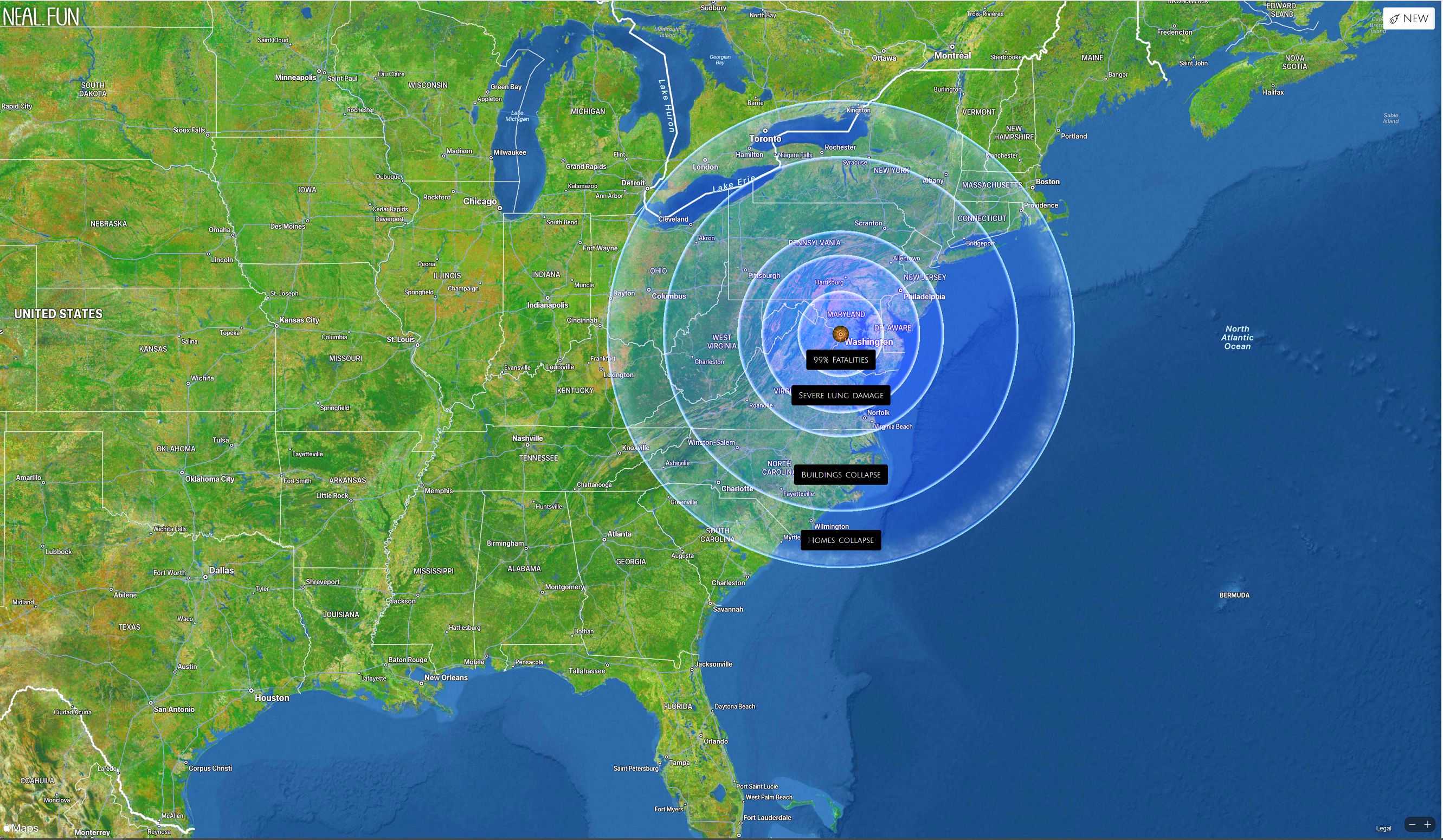This Interactive Map Will Show You How Screwed You Are If We're Hit by an Asteroid
An 1,500 foot diameter iron asteroid striking the edge of Central Park in New York City would kill around 900,000 people on impact. The crater would be 5.6 miles wide and almost 1,900 feet deep. The blast would be equivalent to 9 gigatons of TNT, several orders of magnitude stronger than the largest nuclear bomb ever detonated. I know this thanks to a handy tool called Asteroid Launcher, a browser app that lets people see how devastating the impact of a comet or asteroid could be.
Asteroid Launcher uses Apple Maps to pull satellite footage of the Earth into its simulation. You can scan the planet, place your impact site and adjust various sliders to pick the perfect space object to bring cleansing fire to the planet. Want to drop a mile wide gold asteroid on Washington D.C.? You can. The impact crater would be 28 miles wide.
One of the impressive things about Asteroid Launcher is its layers of visualization. After the asteroid lands, you can scroll through a list of stats. The map updates as you go. The fireball of the solid gold D.C. asteroid could be seen from Toronto. It would incinerate most of New Jersey. Clothes would catch fire within 233 miles of the impact," Asteroid Launcher explained.
Scroll down farther to see the ring of a 243 decibel shock wave radiating out from D.C. Homes would collapse within 408 miles of the impact from the shockwave alone. Eardrums would rupture, more than 3 million would die from the sound. That's more than would die in the initial impact.
 Asteroid Launcher screengrab.
Asteroid Launcher screengrab. The mind behind Asteroid Launcher is Neal Agarwal. A self-described developer with a passion for creative coding. I love playing out disaster scenarios in my head and so I've always wanted a tool that would help visualize the effects of some major natural disaster," he told Motherboard. Asteroids are a good choice since their effects are so far-reaching. I think the tool could also help people gain more appreciation for our need to deflect asteroids like in NASA's DART mission."
A lot of math went into this project. The simulation is based on papers by Dr. Gareth Collins and Dr. Clemens Rumpf," the simulator's about page said. Collins is a professor at the Imperial College London who studies impacts. Clemens Rumpf is a former NASA engineer who has published multiple papers on asteroid impacts and their effect on humanity.
On Twitter, Agarwal said he thought building Asteroid Launcher would only take a month, but the physics were complicated. In the end, Agarwal said the whole thing took about two months to build with the first month dedicated to research.
Agarwal said the most difficult part was learning the asteroid physics. Asteroid impact simulation is a whole area of research and it can get pretty complicated, with supercomputers needed to get the most accurate results," he said. But luckily there's also tons of great resources like Dr. Gareth Collins' scientific papers that simplify the equations and make them more accessible."
Asteroid Launcher is similar to Nuke Map, a project that lets you drop nukes on various parts of the planet and witness the impact. But Asteroid Launcher's visuals are better, its consequences rendered with the eye of an artist. There's something about a pulsing fireball marked with lines explaining when 3rd degree burns begin that makes the possibility of an asteroid impact visceral in a way that Nuke map doesn't quite capture. Nuke Map is a classic and I remember first playing around with it in high school. I definitely took some inspiration from Nuke Map when making this project," Agarwal said.
Agarwal's website is full of fun web projects. Visitors can scroll through the vastness of the ocean to get a sense of its depths and what lurks below the waves, desperately try to spend Bill Gates money, or solve increasingly absurd trolley problems.
According to Agarwal, the response to Asteroid Launcher has been wild. It definitely seems to be a release valve for some as I've seen people fling asteroids at their workplace and rival sports teams," he said. My favorite comment from Reddit was I had a fun time finding an asteroid that was big enough to destroy my workplace but not my apartment.'"